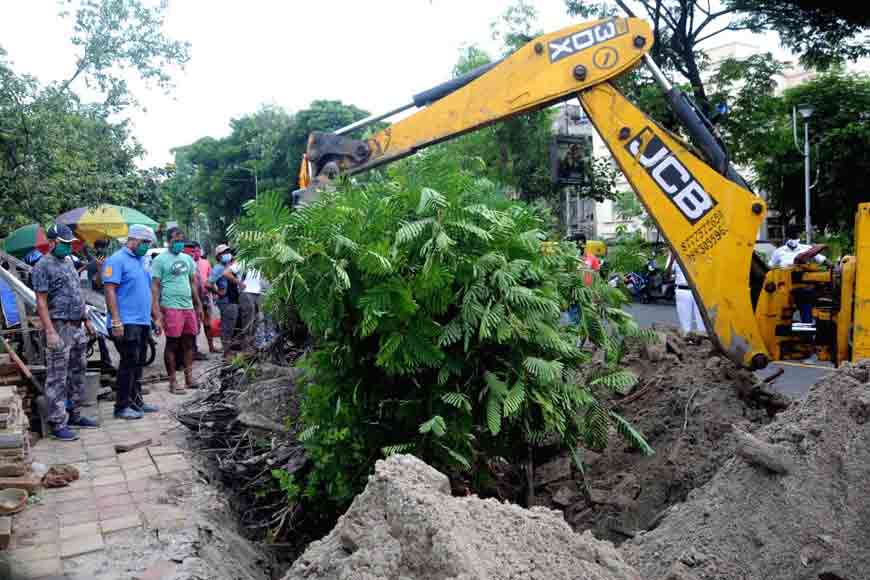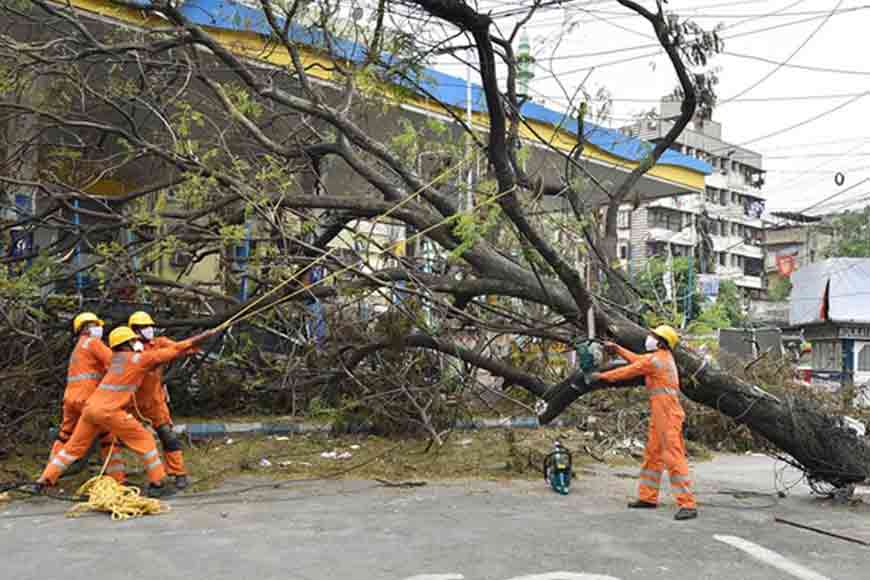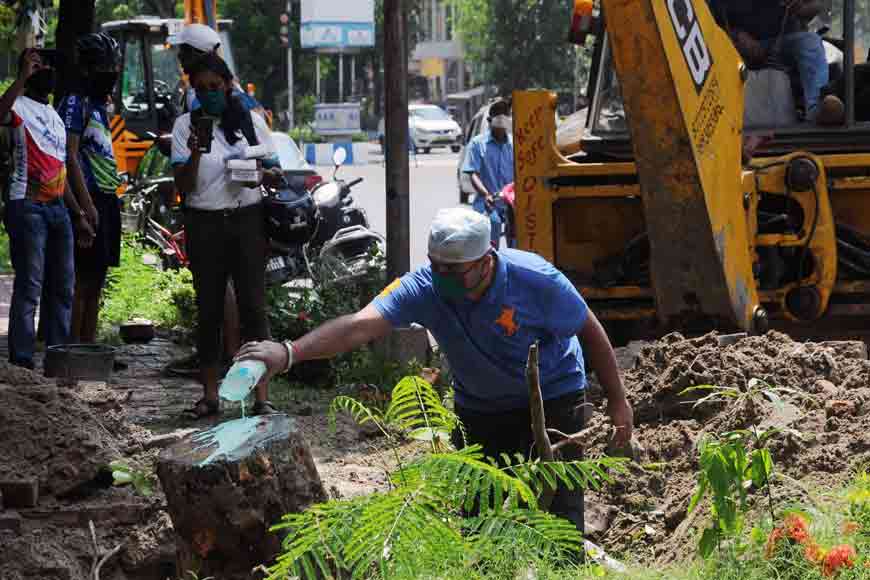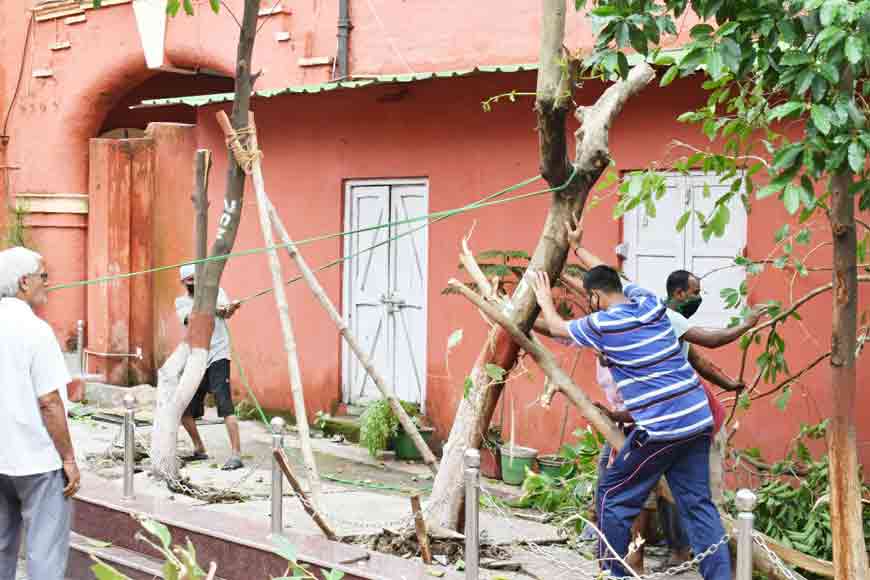How can trees trust the inventor of the axe?

Kolkata’s love for its trees appears to be growing. Unfortunately, thus far, not a single political party has incorporated a ‘tree policy’ in its election manifesto. Or stated their thoughts about trees. Every animal species on this planet cohabits with trees. Yet, humans are the only species to have invented the axe, with which we have been felling trees for thousands of years. In the eyes of a tree, every human is a killer. Meanwhile, however, the Kolkata Municipal Corporation (KMC) has brought about a silent revolution with regard to trees. Let’s hear that story first.

On May 20, Cyclone Amphan tore through Kolkata, leaving a wreck in its wake. That night, an ancient banyan tree near Northern Park in Bhawanipur, partially uprooted by the furious winds, leaned forward to meet the ground. That tree has now been brought back to life through the collective efforts of many. Kolkata Corporation has informed us that the city lost nearly 1,500 trees – among them very old banyan, peepul (aswattha), gulmohar, (Krishnachura or poinciana), and ‘bakul’- to Amphan, of which many have been similarly revived, thanks to local volunteers and the KMC.
In the eyes of a tree, every human is a killer. Meanwhile, however, the Kolkata Municipal Corporation (KMC) has brought about a silent revolution with regard to trees. Let’s hear that story first.
The decision that KMC had taken was to ‘replant’ trees older than 25 years, which had been cleanly uprooted. Accordingly, nearly 300 trees were replanted, of which 285 have shown signs of new life. The largest number of replanted trees, as many as 20, are to be found in Ward 70 in Bhawanipur. Across the city, Royd Street, Northern Park, Justice Chandra Madhab Road, Chakraberia Road, Rabindra Sarobar, and Subhas Sarobar have witnessed intensive replanting. A total of 37 trees were replanted in Subhas Sarobar, of which 33 have survived, says KMC. At Rabindra Sarobar, of the 144 trees which were replanted, 111 have fought their way back to life.

When old trees collapse, or lose their ground and lean to one side, their branches are trimmed before replanting. Then, a crane lifts them and places them back in position. The parts that are trimmed sometimes tend to fester, like wounds, or attract fungal infections, which is why the trees are inspected by experts every two weeks. To prevent malnourishment, they are also supplied with requisite fertilisers, water, and medication.
The decision that KMC had taken was to ‘replant’ trees older than 25 years, which had been cleanly uprooted. Accordingly, nearly 300 trees were replanted, of which 285 have shown signs of new life.
So as KMC claims, 285 trees have been replanted in the city. However, Kolkata has no system in place to conduct an audit of these trees, which would have told us if, a year down the line, they are still alive and also if an exercise that cost the state exchequer considerable funds was at all worth the expense.
But these are all recent experiences, while Kolkata’s love affair with trees goes way back in time. Just think of important neighbourhoods like Nimtala, Taltala, Bakultala, Jhautala, Beltala, Battala, Lebutala, Narkeldanga, Horitoki Bagan, Peyara Bagan, Chalta Bagan, and so on and so forth. Quite clearly, the city shared an intimate bond with its trees once upon a time. The names still exist, the trees don’t. What if they can be brought back, though? Say 100 ‘taal’ trees are planted in Taltala, ‘bakul’ trees in Bakultala, or ‘jhau’ trees in Jhautala, wouldn’t Kolkata really come to life?
En route to the airport from the city at night, you will see electrical wires draped around several trees, so that twinkling multicoloured lights may hang from them. Quite a pleasant sight it is, too. However, as the lights burn through the night, does the heat they produce affect the trees? Does it hamper photosynthesis? Some would say that given the struggle for survival among humans, where is the time to think about trees, stray animals, and such like? The truth is, however, that any development that excludes trees, water bodies, or animal life has gradually been rejected the world over. For example, Kolkata has seen a rapid rise in sodium vapour lamps, which supposedly destroy the reproductive systems of birds. I don’t know if that is true, but since the question has come up, I believe a probe is necessary.
Working for a media house in an office adjoining the EM Bypass in 2013-14, I noticed the regular deaths of a few arjuna trees nearby, at least five or six of them. I knew they were being killed somehow, but couldn’t figure out how. One day, I even called the KMC Control Room to let them know what was happening, and they promised to look into it, but couldn’t, I presume. Many more people have long noticed similar mysterious tree deaths along VIP Road, Jessore Road and B.T. Road. Inevitably, a death is followed by a tree felling, with trucks carrying the remains away. If you watch out for it, you will notice similar deaths around Kolkata’s Brigade Parade Ground. I saw how the huge ‘rudra palash’ tree on the National Library premises died, and noticed a few other skeletons too. I couldn’t tell you whether these deaths are natural or unnatural. How does an ancient tree belonging to the city just die? No answer.

Lights burn through the night, does the heat they produce affect the trees? Does it hamper photosynthesis? Some would say that given the struggle for survival among humans, where is the time to think about trees, stray animals, and such like? The truth is, however, that any development that excludes trees, water bodies, or animal life has gradually been rejected the world over.
A theory, or perhaps rumour, has been in circulation for a while now. It is said that tree killers make a hole near the base of a tree and fill it with ‘hing’ (asafoetida), which slowly kills it off. I asked a couple of botanists, but they could not confirm the theory. Once again, I believe the matter of whether trees are being deliberately killed by hired killers, and whether such killers exist at all, needs investigation.

Something else that is urgently needed in greater Kolkata is a tree census, ward by ward. Let the census report, comprising names and images of individual trees, be uploaded online. Let a 24-hour Tree Control Room be set up, where citizens may call and register complaints about tree felling and associated issues. Simultaneously, let the government present a specific tree planting policy before the Assembly, and let the ‘greening’ of the city be subject to an audit. It is unacceptable that even as the greenery around us is destroyed, we keep holding annual tree planting drives and raise slogans like ‘one tree one life’.
In ancient Indian mythology, as Shakuntala leaves for her husband’s home, she asks her adoptive father, Maharshi Kanva, for permission. In reply, he tells her to ask the trees instead, trees which have been her lifelong companions. When can we restore them to this position again?










